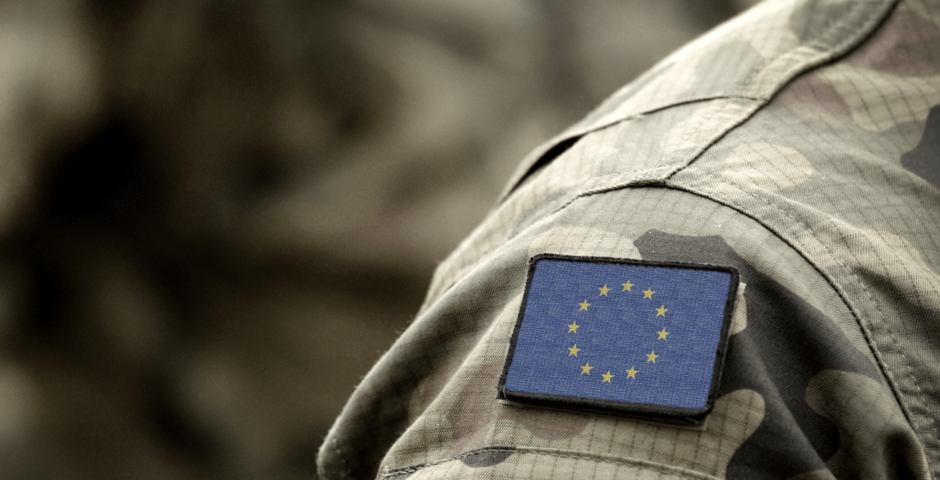The growing momentum of EU defense integration

Shedding light on the EU’s future path towards a self-sustaining defense capacity.
Defense integration could be imperative for ensuring the internal stability of the European Union (EU) in the long term. The EU has been steadily advancing its ambitions in this area over the last decade. Right now, it has the opportunity to accelerate the integration process. This is important because there are many international developments going on at this moment. Think about Russia’s full-scale invasion of Ukraine, the recent outbreak of war and rising tensions in the Middle East, enlargement plans of the BRICS alliance, or a potential re-election of Donald Trump after the 2024 United States (US) presidential elections.
At first glance, these seem to be self-standing developments. However, what unites them all is their potential to threaten the stability of the EU. In the economic sphere, for example, but particularly in terms of security. It is no secret that Trump is an outspoken skeptic of NATO, as he has already hinted at pulling out the US from the military alliance. The enlargement plans for the BRICS alliance, incorporating potentially nuclear-capable powers like Iran and oil-rich countries such as Saudi Arabia and the United Arab Emirates (UAE), moreover, appear to be aimed at rivaling the ‘West’ and its institutions, as stated by the Dutch news outlet NOS.
Especially since the full-scale Russian invasion of Ukraine in February 2022, the urgent need as well as the momentum for defense integration has been growing. Not only top-down from EU heads and policymakers, but from European civil societies as well. The latter is perhaps even more important. This sentiment becomes visible in a 2023 Eurobarometer survey, which shows that 80 percent of European citizens think that EU-wide cooperation in defense matters must be increased. So, what is holding the EU back from becoming more self-sustaining? Is this the moment for the EU to make work of further improving its defense capabilities and defense cooperation?
The historical roots of EU defense policy
We first go back to 9 December 1991, to the Dutch city of Maastricht, the birthplace of the European Union. Here representatives of the then 12 member states met for a European Summit. In Maastricht, the groundwork was laid for not only the EU as the political union as we know it today, but also for establishing the Common Foreign and Security Policy (CFSP). According to the European Council, instead of the rather loose cooperation between member states in the pre-Maastricht era, the new European Union now had the possibility to act and speak on the world stage with one voice.
I hear you thinking, speaking about what? The development of the CFSP was, and still is, aimed at preserving peace, strengthening international security, encouraging international cooperation, developing and consolidating democracy, and upholding the rule of law, as well as the respect for human rights and fundamental freedoms. A mouthful, but important to mention, as the EU operates based on these principles in its pursuit of establishing itself as an external power on the world stage.
An important amendment was made to the CFSP in the 2007 Lisbon Treaty with the formation of the European Security and Defense Policy. Today, this is known as the Common Security and Defense Policy (CSDP). As part of the broader Common Foreign and Security Policy, the CSDP was established to conduct missions outside the Union aimed at peacekeeping, conflict prevention, and strengthening international security, as indicated by the European External Action Service (EEAS). The EEAS, also introduced in the Treaty of Lisbon, is the main diplomatic body of the EU. It carries out the Common Foreign and Security Policy and ensures the coordination of the EU’s external action.
At this moment, the CFSP and CSDP structure is still in place. In recent years, there has been an intention from the EU to deepen this framework by promoting further defense integration. This is, however, difficult to achieve in practice, as this aim has serious challenges. Many of these arise from EU member states and are hard to overcome.
Challenges to EU defense integration
From the European Defense Agency (EDA) 2022 CARD Report, it becomes clear that despite observing an overall increase in total defense spendings of EU member states, most of these member states do not prioritize investing in EU-wide collaborative projects in the same field. In other words, Europe as a whole is spending more money on defense but is, at the same time, also cooperating less.
This contrasting development relates to one of the key challenges of EU defense integration, and of EU integration in general: sovereignty concerns and conflicting national interests of member states. Many member states find it challenging to transfer national control or national decision-making to the EU. In other words, it is problematic for many member states to pool national sovereignty, especially in the security and defense area, to a supranational authority like the Union.
Member states often have opposing national interests and defense priorities, as well as diverse and sometimes conflicting views regarding ‘the European project’ in general. Being against certain aspects of European integration is seen as soft Euroscepticism, while being opposed to the entire European project is known as hard Euroscepticism. According to the European Commision, in Hungary, Poland, Italy, and France, Eurosceptic parties represent at least half of the electorate. In the Netherlands and Sweden, this exceeds a quarter of the electorate. In Hungary and Poland, we have seen the practical implications for the EU when member states are being governed by Eurosceptic administrations.
In light of the above, further defense integration asks for a substantial amount of unity and solidarity among member states concerning this aim. This strengthened after the outbreak of war in Ukraine, but will remain complex. This corresponds with what is often referred to as the, and forgive me for the political science jargon, ‘liberal intergovernmental logic’, wherein the alignment of interests and broad agreement among member states is central to European integration and cooperation.
EU member states, therefore, must be convinced of the comparative advantage of more centralized power and capability of the Union in the area of security and defense. Only then can concrete efforts be made to bolster self-reliance, while reducing dependency on and assistance from the US at first, and being able to operate outside of NATO structures in the long term. As such, enhanced defense integration as envisioned in this article requires bold ideas, new efforts, and decisive actions.
The EU’s progress on defense integration
Despite these challenges, the EU has presented new initiatives in the last decade. The initiatives not only highlight the EU’s ongoing intention for defense integration but also demonstrate its practical feasibility. Recent initiatives are, among others, the European Defense Fund (EDF) and the Permanent Structured Cooperation (PESCO). Also, the Strategic Compass for Security and Defense is interesting to watch, as it holds plans for reinforcing the EU’s security and defense policy in the upcoming years.
Established in 2017, the EDF has the purpose of financing collaborative EU-wide defense research, and of assisting in investments of member states by co-financing the costs for defense capabilities, as articulated by the European Defense Agency itself. Meanwhile, PESCO, formed in 2017 as well, emphasizes developing and investing in shared military capability projects among EU member states. PESCO centers around strengthening the operational readiness of Europe’s armed forces. As voiced by the European External Action Service (EEAS), its primary aim is to develop defense capabilities jointly and to make these available for EU military operations. This will, according to the EEAS, enhance the EU’s capacity to function as an international security actor and contribute to the protection of EU citizens.
Lastly, and perhaps most relevant for the future direction of EU defense integration, is the Strategic Compass for Security and Defense, from March 2022. According to the EEAS, the aim of making the Union “a stronger and more capable security provider” is made possible in the Compass by concrete proposals to “improve the EU’s ability to act decisively” in times of security crises. The Compass holds, among others, plans to establish an EU Rapid Deployment Capacity of up to 5000 troops, to hold regular military exercises on land and sea, to improve military mobility and interoperability across member states, and to foster technological innovation within the defense sector.
How to move forward for the EU?
Why does the EU need to prioritize defense integration in the first place? The core objective is to shape a European Union that is strategically autonomous from other powers. A self-sustaining EU that is not operationally or materially dependent on the US or NATO in its defense capabilities is vital in an ever-changing balance of power. With this, we refer to the shifting state of the international order, in which, as seen in the introduction, current and future insecurities are central for the EU.
So, what concrete steps can the EU take to promote further defense integration? Initially, the EU must maintain an ongoing and constructive dialogue with member states to explore deeper defense integration. Allowing the EU to have more responsibilities in the security and defense area cannot result in a zero-sum outcome, in which the EU gains power while member states lose sovereignty in an area that is traditionally considered to be a national competency. In other words, member states must be convinced – either by political, financial, or both means – of the structural benefits of defense integration. Creating solidarity around this aim is difficult in practice, but it must be the starting point.
Second, and considering the above, the EU must further engage in tackling the high level of fragmentation in Europe’s military forces, which leads to differences in military capabilities among member states. Overall, this leads to less consistency and interoperability in times of (future) crises. Third, the EU must, therefore, accelerate the standardization of military equipment among member states. In this process, member states retain control over their own militaries, while their capabilities are being Europeanized. This can lead to heightened operational readiness. In this pursuit, PESCO already functions as a starting point. The Strategic Compass holds promising plans as well. Fourth, the EU must further engage in, and assist with securing long-time financial commitment from member states in domestic defense spendings. And fifth, most importantly, the EU must internally develop a long term defense planning or framework that navigates a future path to strategic independence from the US and/or NATO, while emphasizing member state input and civil society engagement.
Bram Breimer holds a Bachelor’s degree in Political Science from the Vrije Universiteit Amsterdam, focusing on Global Politics and International Security. He is currently pursuing a Master’s degree in European Politics and External Relations at the University of Amsterdam.
Image: Shutterstock




